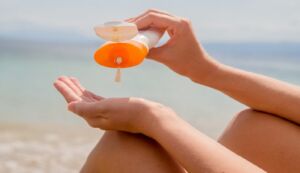The Sunscreens Dermatologists Actually Use: Sun damage significantly affects our skin, damaging cells and proteins, contributing to skin cancer, and accelerating up to 80% of the skin’s natural aging process. So, whether you’re in your early 20s or late 60s; wear makeup daily or embrace the bare face; you’re a complete skincare addict, or do the bare minimum to get by, there’s one thing that you absolutely can’t avoid including in your daily skincare routine: sunscreen.
In fact, if there’s one beauty tip dermatologists agree on, it’s that sunscreen is one of the best photoaging weapons you can have in your skincare arsenal. “My number one piece of advice for daily taking care of your skin is simple. Use sunscreen daily and reapply!” advises Dr. Melissa Levin, board-certified dermatologist and founder of Entière Dermatology in New York. Dr. Levin talks us through what makes a dermatologist-recommended sunscreen, and what you should be looking for when searching for your ideal sun protection.
What to look for in a dermatologist-recommended sunscreen
1. Make sure it’s broad spectrum
First things first, what is broad protection sunscreen? It’s the only kind of sunscreen recommended in The American Academy of Dermatology’s guidelines on sunscreen, and with good reason: it protects your skin from both UVA and UVB rays.
“The solar radiation that reaches us every day is made up of different rays, which affect our skin in different ways,” explains Dr. Levin. “UVA rays are largely responsible for premature skin aging, so they provoke changes in the skin such as the appearance of wrinkles and sunspots. We often call UVB rays ‘burning’ rays, as they’re the culprit behind sunburn and tanning in your skin.” In addition, both types of ray can contribute to the risk of developing skin cancer. “For the best all-over protection, choose broad spectrum formulas,” advises Dr. Levin. “This way, you can be sure you’re tackling both UVA and UVB damage.”
2. The higher the SPF, the better
“One of the biggest misconceptions about sunscreen is that if you have skin of color, you don’t need to be using a high SPF,” says Dr. Levin. “The truth is, everyone should be using an SPF of at least 30.”
SPF, or sun protection factor, is a measurement for the amount of time that your sunscreen will help protect your skin from solar radiation. When making your choice, it’s best to look for a higher SPF, such as an SPF 50 or SPF 50+ sunscreen, as this increases the time it would take for your skin to burn when in direct sunlight.
In addition to SPF numbers, Dr Levin has another useful SPF tip for us to consider. “Apart from recommending a higher SPF sunscreen, I always remind patients that it’s really important to apply sunscreen exactly as it says on the label. This is the way the sunscreen has been tested, so to get the same level of protection, you need to apply following the instructions!”
3. Search for skin-boosting ingredients
To get the maximum benefit from your sunscreen, look for one which contains additional ingredients that go beyond protection. The most advanced formulations now help care for your skin in other ways, with additions such as peptides to help target signs of premature skin aging, and antioxidants, for added protection against oxidative damage.
“I frequently recommend ISDIN’s Eryfotona sunscreens to my patients,” says Dr, Levin. “They don’t just help protect from the sun – they contain enzymes which help repair existing sun damage in the skin, and vitamin E, which helps boost the skin’s natural antioxidant defenses. As a physician, I love this total approach to sun protection and care.”
The secret behind ISDIN’s sunscreen repair mechanism? Eryfotona sunscreens use a unique formulation containing DNA Repairsomes®, otherwise known as photolyase. This naturally-occurring enzyme is derived from plankton, and has been clinically proven to directly help repair UV-induced damage in the skin.
4. Choose a texture that you love
“I always tell my patients that the best kind of sunscreen is one they’ll want to apply every single day,” Dr. Levin tells us. “A lot of the people I see hate sunscreen because they’re so used to white, sticky finishes and chalky textures that just don’t absorb, but that isn’t the case any more!”
ISDIN’s Eryfotona Actinica and Eryfotona Ageless use the latest in formulation technology to create 100% mineral sunscreens that don’t leave behind a greasy, white residue. “ISDIN’s mineral formula is ultralight and absorbs incredibly quickly,” explains Dr. Levin. “My patients also love the tinted sunscreen, Eryfotona Ageless, because they can apply throughout the day without ruining any makeup.”
Bottom line? If you want to keep your skin as safe as possible, providing protection against sun damage and photoaging in the skin, sunscreen is a must. As Dr. Levin says, “The sun doesn’t take a day off! I wear sunscreen 365 days a year, and encourage my patients to do the same.” So, whichever type of sunscreen you choose, apply it daily, and apply it well!

